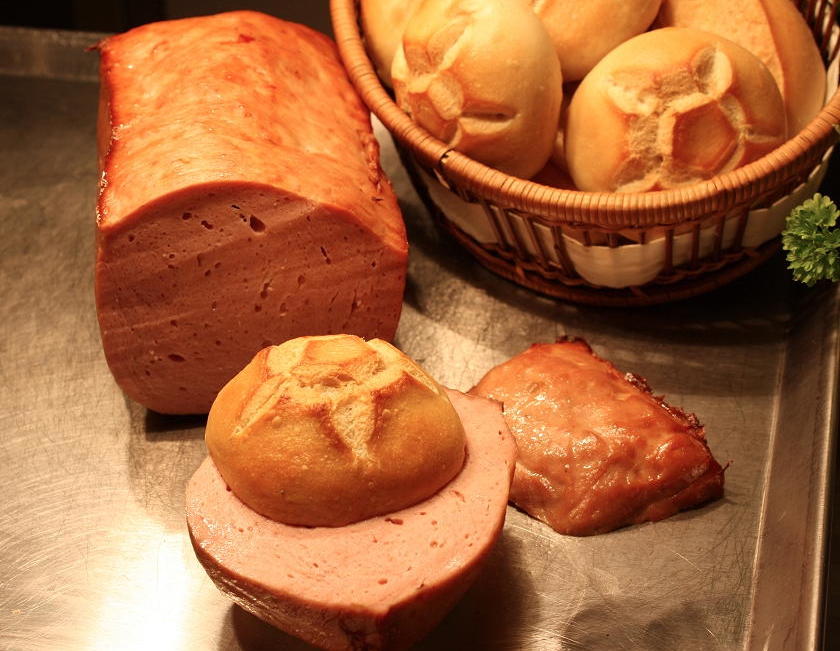German Leberkaese Recipe

If you live in the USA or far away from Germany, you know that it is not so easy to find German Leberkaese. But it is so good! Especially with a fresh baked roll. That’s why we found a homemade Leberkaese recipe for you.
German Leberkaese or Fleischkäse is a Southern German Meat specialty that has become famous all over the world. But even “Leber” means liver, it necessarily doesn’t contain liver. Here’s the deal per Germany’s precise rules:
If it’s called Leberkäse anywhere else but Bavaria, it must contain liver. If not it must be called Bavarian Leberkäse. And for the Stuttgarter Leberkäse the liver amount must contain minimum five percent.
The name Leberkäse originated from the German word “Laib”, which means “loaf”, and “Kas”, which means “compact edible mass”. The first Leberkäse may have been baked in bread pans, and its shape is similar to some cheeses.
In Germany it is delicious cold or warm as a snack: One thicker slice of Leberkaese in a roll with mustard, or cold as a sandwich with various bread.
You can also pan-fry it with onions or make a fake Schnitzel, the “Leberkäse Schnitzel”. If you top it with ham and a fried egg you get the dish “Strammer Max” photo below – Find the Recipe here – The recipe for making Leberkäse below is a proven recipe. Happy Cooking!

Ingredients German Leberkaese Recipe
600 g lean beef (use stewing stake, ground twice)
400 g ground pork (ground it twice )
100 g bacon finely chopped (without the rind)
1-2 Tsp salt (or to taste)
1 tsp white ground pepper
2 tbsp corn starch and 2 tbsp marjoram
1 tsp paprika powder (sweet) optional
2 medium sized onions (run through with the meat)
1 slice bread to clean grinder (run through last)
a very little nutmeg, just the tip of a knife
1 tsp Pink salt or Curing salt (see under Tips what to use)
500 ml crushed ice
1 Meat Grinder – Find it here on Amazon –

Cooking Instructions
The meat should be very cold before you use it and should not get warm at any time during the process of making Leberkaese.
– Grind the beef and pork very finely by using a food processor or a meat grinder (grinding plate fine).
– Peel onion and cut it coarsely.
– Mix the beef and pork with the crushed ice until sticky (emulsify).
– Add the onion, spices, cornstarch and mix once again, keep the mixture well chilled.
– Add the bacon at the very end. Make sure the bacon is distributed evenly throughout the mixture. Run the bacon through with the meat as well.
– If you use a grinder, run some bread through the grinder, it will clean it.
– Grease loaf dishes with butter. then place the meat into the dishes and place in fridge for about an hour.
– Pre-heat oven to 180 C of 350 F.
– Even out the surface and with a knife cut the typical criss cross patter into the surface.
– Bake for about 30-45 minutes, depending on size of your dish; convection oven on 320 F, medium rack.
– When done, leave to rest for five minutes, then slice.
TIPS
You also can use different meat. Instead of pork and beef use lamb, turkey or liver.
Add some fresh finely chopped herbs like parsley or Italian herbs (Thyme, marjoram, oregano).
Curing salt is used to get the nice pink color. Without curing salt the meat color will not be pink, it will be grayish.
CURING SALTS
- Prague Powder
Some people refer to this as “pink curing salt”. There are 2 varieties:
Prague Powder #1 is for all cured meats and sausages except for the dried kinds like hard salami. It is 6.25 per cent sodium nitrite and 93.75 per cent sodium chloride (table salt).
Prague Powder #2 is used for dried meat and sausage. It has 1 ounce of sodium nitrite and 0.64 ounces of sodium nitrate in a pound of product. The rest of the pound is sodium chloride.
Both Prague Powder #1 and #2 are used in very small quantities, around 1 teaspoon per 5 pounds of meat (follow supplier directions).
- Morton Tender Quick
This is a curing salt made by the Morton Salt Company. It contains both sodium nitrite and sodium nitrate. It has a lower nitrite/nitrate concentration (0.5 percent of each), and much more salt than the other cures.
Tender Quick is very good to use as a rub or in a brine (for making corned beef etc.) but has limited use in sausage making. With Tender Quick the sausage mixture gets very salty before the correct amount of cure is reached.
Tender Quick from Morton – Find it here
- Insta Cure
This is essentially the same product as Prague Powder. It comes as Insta Cure #1 and #2, and the uses are the same as for Prague Powder #1 and #2.
Video How to make Leberkaese – It’s in German with English subtitles
Ingredients from the Video for 3kg meat & bacon
1600g pork, lean
600-750g lean beef
600g pork bacon, without meat, pure fat is best
1200ml water frozen as ice
60 grams of salt
9 grams of white pepper
1.5 grams of cardamom
6 grams nutmeg powder
1.5 grams of ginger powder
1.5 cloves of garlic
90 grams of cornstarch
Half Onion
15 grams of cutter aid or phosphate or baking powder containing phosphate
3 grams of seasoning (Fondor) – Find it here on Amazon –
oil for the mold
Baking Time and Temperatures
10 minutes 150°C with top and bottom heat
Approx. 3 hours at 120°C top and bottom heat (also depends on when the 70°C inside the meat loaf was reached)
Then maybe a few more minutes at 180°C top and bottom heat









